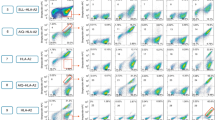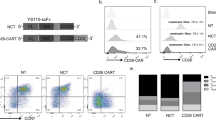Abstract
The LIM-domain protein LMO2 is a T-cell oncogenic protein first recognized by gene activation through chromosomal translocations, but it is also responsible for leukaemias arising as secondary, adverse effects in an X-SCID gene therapy trial. There are no specific reagents currently available to analyse the LMO2 multiprotein complex or to combat LMO2-dependent leukaemias. Accordingly, we have isolated an anti-LMO2 single chain Fv antibody fragment to determine if intracellular interference with LMO2-protein complexes can avert LMO2-dependent functions in normal and cancer settings. The anti-LMO2 single chain Fv, obtained using Intracellular Antibody Capture (IAC) technology, is specific for LMO2 among the LIM-only protein family and binds LMO2 through the third and fourth LIM fingers. Using vector-mediated expression of anti-LMO2 scFv, we show inhibition of Lmo2-dependent erythropoiesis but not endothelial development. We also demonstrate inhibition of Lmo2-dependent leukaemia in a mouse T-cell tumourigenesis transplantation assay with retroviral-mediated expression of anti-LMO2 scFv. Our studies establish that interference with the LMO2 multiprotein complex inhibits both normal and tumourigenic roles. The antibody fragment is a tool for dissecting LMO2 function in haematopoiesis and leukaemia and is a lead for development of therapeutics against LMO2-dependent T-ALL.
This is a preview of subscription content, access via your institution
Access options
Subscribe to this journal
Receive 50 print issues and online access
$259.00 per year
only $5.18 per issue
Buy this article
- Purchase on Springer Link
- Instant access to full article PDF
Prices may be subject to local taxes which are calculated during checkout




Similar content being viewed by others
References
Alderton G . (2007). Intra-fering with interactions. Nat Rev Cancer 7: 570–571.
Bai S, Thomas C, Rawat A, Ahsan F . (2006). Recent progress in dendrimer-based nanocarriers. Crit Rev Ther Drug Carrier Syst 23: 437–495.
Fizzotti M, Chen EY, Link MP, Carroll AJ, Foroni L, Rabbitts TH et al. (1994). Simultaneous expression of RBTN2 and BCR-ABL oncogenes in a T-ALL with a t(11;14)(p13;q11) and a late appearing Philadelphia chromosome. Leukaemia 8: 1124–1130.
Forster A, Pannell R, Drynan L, Cano F, Chan N, Codrington R et al. (2005). Chromosomal translocation engineering to recapitulate primary events of human cancer. Cold Spring Harb Symp Quant Biol 70: 275–282.
Grutz G, Forster A, Rabbitts TH . (1998). Identification of the LMO4 gene encoding an interaction partner of the LIM-binding protein LDB1/NLI1: a candidate for displacement by LMO proteins in T cell acute leukaemia. Oncogene 17: 2799–2803.
Hacein-Bey-Abina S, von Kalle C, Schmidt M, McCormack MP, Wulffraat N, Leboulch P et al. (2003). LMO2-associated clonal T cell proliferation in two patients after gene therapy for SCID-X1. Science 302: 415–419.
Holt LJ, Bussow K, Walter G, Tomlinson IM . (2000). By-passing selection: direct screening for antibody-antigen interactions using protein arrays. Nucleic Acids Res 28: E72.
Karlsson O, Thor S, Norberg T, Ohlsson H, Edlund T . (1990). Insulin gene enhancer binding protein Isl-1 is a member of a novel class of proteins containing both a homeo- and a cys-his domain. Nature 344: 879–882.
Kenny DA, Jurata LW, Saga Y, Gill GN . (1998). Identification and characterization of LMO4, an LMO gene with a novel pattern of expression during embryogenesis. Proc Natl Acad Sci USA 95: 11257–11262.
Larson R, Fisch P, Larson T, Lavenir I, Langford T, King G et al. (1994). T cell tumours with disparate phenotypes develop with long latency in mice transgenic for rbtn2. Oncogene 9: 3675–3681.
Larson RC, Lavenir I, Larson TA, Baer R, Warren AJ, Wadman I et al. (1996). Protein dimerisation between Lmo2 (Rbtn2) and Tal1 alters thymocyte development and potentiates T cell tumorigenesis in transgenic mice. EMBO J 15: 1021–1027.
Larson RC, Osada H, Larson TA, Lavenir I, Rabbitts TH . (1995). The oncogenic LIM protein Rbtn2 causes thymic developmental aberrations that precede malignancy in transgenic mice. Oncogene 11: 853–862.
Nam CH, Rabbitts TH . (2006). The role of LMO2 in development and in T cell leukemia after chromosomal translocation or retroviral insertion. Mol Ther 13: 15–25.
Neale GA, Rehg JE, Goorha RM . (1995). Ectopic expression of rhombotin-2 causes selective expansion of the thymus and T-cell tumours in transgenic mice. Blood 86: 3060–3071.
Peer D, Karp JM, Hong S, Farokhzad OC, Margalit R, Langer R . (2007). Nanocarriers as an emerging platform for cancer therapy. Nat Nanotechnol 2: 751–760.
Racevskis J, Dill A, Sparano JA, Ruan H . (1999). Molecular cloning of LMO4, a new human LIM domain gene. Bioch Biophys Acta 1445: 148–153.
Sheets MD, Amersdorfer P, Finnern R, Sargent P, Lindqvist E, Schier R et al. (1998). Efficient construction of a large nonimmune phage antibody library: the production of high-affinity human single-chain antibodies to protein antigens. Proc Natl Acad Sci USA 95: 6157–6162.
Spanopoulou E, Roman CA, Corcoran LM, Schlissel MS, Silver DP, Nemazee D et al. (1994). Functional immunoglobulin transgenes guide ordered B-cell differentiation in Rag-1 deficient mice. Genes Dev 8: 1030–1035.
Tanaka T, Lobato MN, Rabbitts TH . (2003). Single domain intracellular antibodies: a minimal fragment for direct in vivo selection of antigen-specific intrabodies. J Mol Biol 331: 1109–1120.
Tanaka T, Rabbitts TH . (2003). Intrabodies based on intracellular capture frameworks that bind the RAS protein with high affinity and impair oncogenic transformation. EMBO J 22: 1025–1035.
Tanaka T, Williams RL, Rabbitts TH . (2007). Tumour prevention by a single antibody domain inhibiting binding of signal transduction molecules to activated RAS. EMBO J 26: 3250–3259.
Tse E, Lobato MN, Forster A, Tanaka T, Chung GTY, Rabbitts TH . (2002). Intracellular antibody capture technology: application to selection of single chain Fv recognising the BCR-ABL oncogenic protein. J Mol Biol 317: 85–94.
Van Parijs L, Refaeli Y, Lord JD, Nelson BH, Abbas AK, Baltimore D . (1999). Uncoupling IL-2 signals that regulate T cell proliferation, survival, and Fas-mediated activation-induced cell death. Immunity 11: 281–288.
Wadman IA, Osada H, Grutz GG, Agulnick AD, Westphal H, Forster A et al. (1997). The LIM-only protein Lmo2 is a bridging molecule assembling an erythroid, DNA-binding complex which includes the TAL1, E47, GATA-1 and Ldb1/NLI proteins. EMBO J 16: 3145–3157.
Warren AJ, Colledge WH, Carlton MBL, Evans MJ, Smith AJH, Rabbitts TH . (1994). The oncogenic cysteine-rich LIM domain protein rbtn2 is essential for erythroid development. Cell 78: 45–58.
Yamada Y, Warren AW, Dobson C, Forster A, Pannell R, Rabbitts TH . (1998). The T cell leukaemia LIM protein Lmo2 is necessary for adult mouse haematopoiesis. Proc Natl Acad Sci USA 95: 3890–3895.
Acknowledgements
This work was supported by the Medical Research Council. CHN was supported by a fellowship from the Lady Tata Memorial Trust. We would like to thank Dr T Kitamura (University of Tokyo) for PlatE packaging cells and Dr D Baltimore (California Institute of Technology) for pMIG vector.
Author information
Authors and Affiliations
Corresponding author
Additional information
Conflict of interests
The authors have no conflicting financial interests.
Supplementary Information accompanies the paper on the Oncogene website (http://www.nature.com/onc).
Rights and permissions
About this article
Cite this article
Nam, CH., Lobato, M., Appert, A. et al. An antibody inhibitor of the LMO2-protein complex blocks its normal and tumorigenic functions. Oncogene 27, 4962–4968 (2008). https://doi.org/10.1038/onc.2008.130
Received:
Revised:
Accepted:
Published:
Issue Date:
DOI: https://doi.org/10.1038/onc.2008.130
Keywords
This article is cited by
-
T-ALL can evolve to oncogene independence
Leukemia (2021)
-
Cancer cell killing by target antigen engagement with engineered complementary intracellular antibody single domains fused to pro-caspase3
Scientific Reports (2019)
-
Conformational flexibility of the oncogenic protein LMO2 primes the formation of the multi-protein transcription complex
Scientific Reports (2014)
-
LIM-domain-only proteins: multifunctional nuclear transcription coregulators that interacts with diverse proteins
Molecular Biology Reports (2014)
-
LIM-domain-only proteins in cancer
Nature Reviews Cancer (2013)



